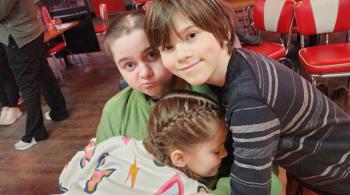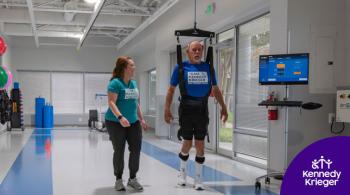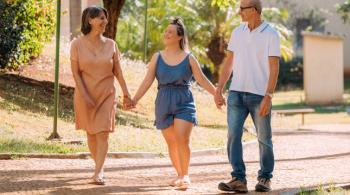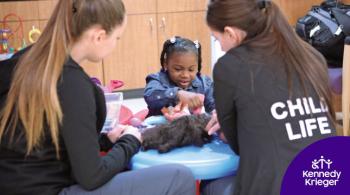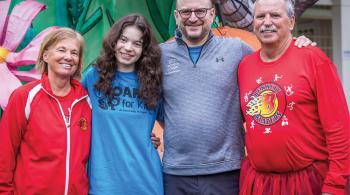By Laura Thornton
Dale will never forget the day he saw his daughter Lydia walk again.
It was back in January, and Lydia, now 11, had been at Kennedy Krieger Institute’s inpatient rehabilitation hospital for about two months. She’d experienced a traumatic brain injury the previous fall, when a truck hit her family’s minivan on their way home from church, and she was relearning how to do just about everything.
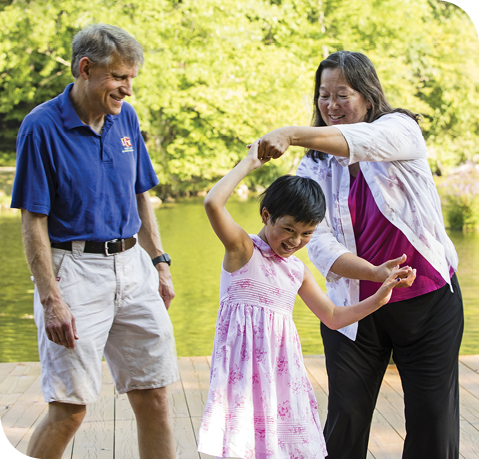
“One of her therapists said, ‘Show your dad what you can do!’” Giddy with excitement, Lydia walked part-way across the room, all by herself. “It was a big moment,” Dale says.
That’s because when Lydia arrived at Kennedy Krieger, she couldn’t sit up, or even hold her head up on her own. Her injury had disrupted the signaling process her brain uses to get her body to move. She could give a thumbs-up for “yes” and a thumbs-down for “no,” and she could say “mommy.” But her parents had no idea if she’d ever talk in complete sentences again, let alone laugh, tell a joke or even smile.
Nevertheless, Lydia started right away on the road to recovery with a combined three to four hours of intensive physical, occupational and speech-language therapies a day, much of it disguised as games or other fun activities. She also began working with specialists in neuropsychology, behavioral psychology, child life, therapeutic recreation and education. “They were doing so many amazing things that I’d never have thought of myself,” says her mom, Amy.
As Lydia’s injury was to the right side of her brain, which controls left-side vision and movement, she didn’t initially respond to any stimuli on the left side of her body. Many of her therapies were geared toward getting her to use her left side again. For example, physical therapist Elena Bradley used musical toys to get Lydia to look to the left, and occupational therapist Danielle Matteo encouraged Lydia to color on the left side of a piece of paper.
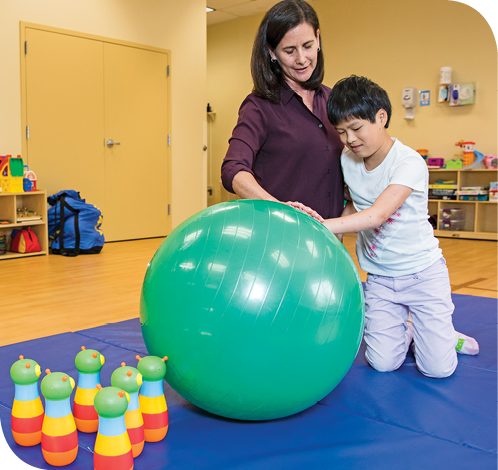
Other therapies helped Lydia redevelop her cognitive abilities and memory. For example, speech-language pathologist Dana Wanyo helped Lydia create a memory log of pictures and words indicating what had happened throughout the day. When Lydia forgot a word, Wanyo encouraged her to describe it.
Bradley also worked Lydia through a range of supported sitting and standing positions to get her used to being upright again. And Lydia strengthened her arms, legs and core at aquatic therapy sessions.
“Her therapists kept pushing her in a good way,” Amy says. Lydia started telling jokes again. Soon, she was ready to try walking—first with a walker, then a cane. And then, as Dale looked on, Lydia walked without any assistance at all.
‘Aha!’ Moments
By the end of January, Lydia was home from the hospital and attending the Institute’s Specialized Transition Program, an intensive outpatient program, where she continued to make great progress. Kennedy Krieger nurse clinical care manager Kristine Mauldin had made sure there would be a spot for Lydia in the program as soon as Lydia was no longer an inpatient.
“This program was designed for children like Lydia,” explains Dr. Beth Slomine, co-director of the Institute’s Center for Brain Injury Recovery. “She made so much progress as an inpatient, and we wanted to maintain that momentum through daily therapies in an intensive outpatient setting.”
Lydia more than kept up the pace. “She surprised herself—and us—every day with the gains she was making,” physical therapist Erin Naber says. “She’d come in, and all of a sudden, she could move her left foot or open her left hand—something she couldn’t do the day before. We had a lot of ‘Aha!’ moments.”

Therapists at the program helped Lydia become more independent and get ready to go back to school. Lydia did craft projects with occupational therapist Nicole Whiston, using markers, glue sticks and scissors—things she’d need to be able to use at school—to improve her fine motor skills.
“She was so motivated by imaginative, fun activities that it was easy to keep her engaged,” Whiston says.
Lydia began each session with speech-language pathologist Brynn Schor with a grin and a question: “Are we going to tell stories today?” Telling stories, and focusing on the “who, what, when, where, why and how” of what Lydia was trying to say, was one way Schor helped Lydia relearn how to organize her thoughts.
In the intensive outpatient program’s classroom, Lydia started doing schoolwork again. “We figured out where she was in reading, writing and math,” explains educational specialist Julie Gardner, “and built a program for her.” Gardner ensured that Lydia had an individualized education program (IEP) in place before returning to school.
And one of the program’s mental health therapists provided Lydia and her family members with counseling and support to help them cope with Lydia’s new challenges and recover from the emotional trauma of the collision that had caused Lydia’s injury.
A Joke and a Smile
“One of Kennedy Krieger’s strengths,” Dr. Slomine says, “is our continuum of care—from our inpatient hospital to our outpatient programs, clinics and follow-up care.” Lydia’s care team members—including Mauldin and Lydia’s many therapists, doctors and other specialists—worked together to ensure seamless transitions for Lydia from one care setting to another.
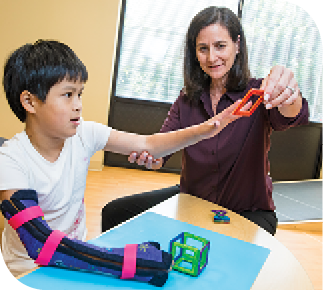
After attending the intensive outpatient program, Lydia started weekly physical, occupational and speech-language therapy sessions at the Institute’s outpatient clinic in Columbia, Maryland, near where she lives.
In occupational therapy, Lydia worked on using her left arm and hand more spontaneously. In one exercise, occupational therapist Stacy Merenstein taped Barbie dolls to the underside of a swing. As she and Lydia lay on the floor under the swing, she asked Lydia to reach up with her left hand and pull the Barbie dolls off the swing.
“Lydia has a fantastic imagination,” Merenstein explains. “We pretended the Barbies were going to a ball, and she needed to get them ready. She loved it.
“It’s play with a purpose,” Merenstein adds. “The activities are designed to increase her ability to use her left arm and hand for reaching, playing and performing self-care skills.”
Lydia also worked on communicating more effectively in speech-language therapy. For example, speech-language pathologist Laura Hyde would ask Lydia to organize a set of picture cards into their correct sequence, then tell a story based on the cards. In the outpatient center’s therapy kitchen, Hyde and Lydia made cookies together, with Lydia practicing following written directions, describing ingredients and narrating what she was doing.
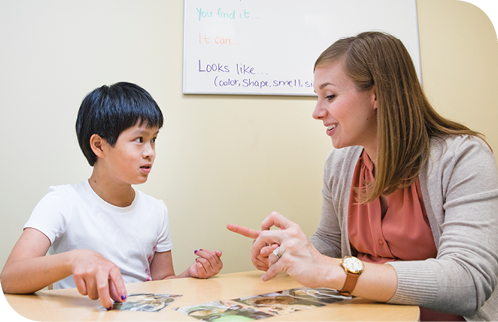
And in physical therapy, physical therapist Deanna Johnson helped and encouraged Lydia to walk more evenly and symmetrically, go up and down stairs without using a railing, balance on one leg, and get up from the floor without using her arms.
Once or twice a year, Lydia visits the Institute for a follow-up evaluation with a physician, a neuropsychologist, a behavioral psychologist and Gardner, who works with Lydia’s teachers throughout the school year to recommend changes to Lydia’s IEP based on her rehabilitation progress. Lydia will continue to be evaluated by her follow-up team for at least a few years.
Near the end of the school year last spring, Lydia returned to school. “She’s very social,” Amy explains. “I know she would have been devastated if she hadn’t gotten to finish up the school year.”
On her first day back, “she was so glad to see everyone. She knew the names of all her teachers and classmates,” Amy says, “and she had a joke—and a smile—for everyone.”









